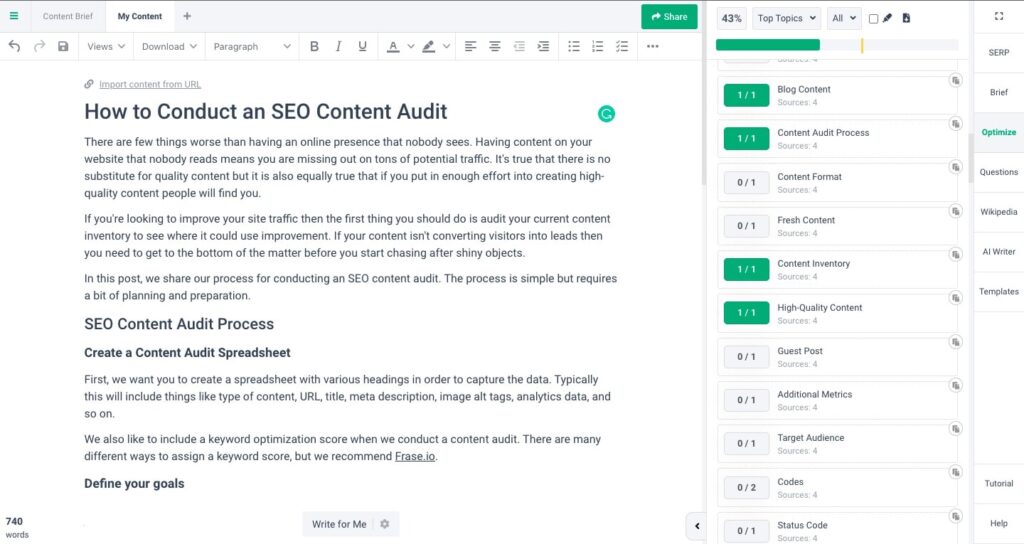There are few things worse than having an online presence that nobody sees. Having content on your website that no one engages with means…
There are few things worse than having an online presence that nobody sees. Having content on your website that no one engages with means you are missing out on tons of potential traffic. There’s no substitute for quality content, if you put in enough effort into creating high-quality content, then people will find you.
If you’re looking to improve your site traffic, then the first thing you should do is audit your current content inventory to see where it could use improvement. If your content isn’t converting visitors into leads, you need to get to the bottom of the matter before you start chasing after shiny objects.
In this post, we share our process for conducting an SEO content audit. The process is simple but requires a bit of planning and preparation.

Content marketing and SEO are inseparable. The more these teams work together and understand the reasons why certain decisions were made will help the team get to a finished product quicker in the future.
If you’re outsourcing the project, obviously the two teams will not collaborate on the project. However, both teams can have a shared meeting when the results of the audit are complete.
If you’re conducting the audience in-house at a minimum, you will want to have a shared meeting when the project is completed instead of dumping the project on the content team with little to no discussion.
First, we want you to create a spreadsheet with various headings in order to capture the data. You can use Excel, Google Sheets, or another solution to create your spreadsheet. Typically your content audit spreadsheet will include things like type of content, target keyword, URL, title, meta description, image alt tags, analytics data, and so on.
We also like to include a keyword optimization score when we conduct a content audit. There are many different ways to assign a keyword score, but we recommend Frase.io. Frase updates your optimization score as you write content, but you can also use it to update an existing piece of content.

In the screenshot of the Frase editor above, you can see a keyword optimization score of 43%. Our content requires a minimum score of 70% before publishing a piece of content.
Feel free to customize your spreadsheet to include additional performance metrics.
The spreadsheet helps you lay out everything that needs to be done and tracks your progress. Now it’s time to define your business goals.
You might be looking to generally improve the content across your website and to make sure that your audience has access to the best information. Refreshing content is a great way to do both! You might want to make a few quick edits to update the information in a blog post or add an internal link to a new blog post related to older evergreen content. You will also want to eliminate any broken links on your website.
Alternatively, you could be looking to have more visibility in the search engines. This requires you to get a little more technical. Take off your writer’s hat and try on your SEO hat, even if it’s a little tight. You can optimize URLs, meta descriptions, or focus on link building.
After creating your spreadsheet and establishing your goals, it’s time to make a list of all the content that you want to analyze. This will usually include web pages, landing pages, and blog posts.
If you have a smaller website, you can easily copy and paste this information into their spreadsheet. But the number of pages required can vary dramatically between websites. Some websites could have a single page and effectively share enough information to help a visitor understand what they offer. Other websites NEED 100s of pages. If your website falls in the second category, you may want to use a tool such as Screaming Frog (https://www.screamingfrog.co.uk/seo-spider/).
Now it’s time to categorize the content that you listed and to pull in analytics metrics. You will want to make a note of the content type, for example, a blog post. If your content strategy has different blog post types, you may want to further categorize blog posts. Example categories could be general, Q&As, guest posts, and product-focused. With blog posts, it’s worth including the date the post was published or last updated.
At this step, you will be analyzing the data that you’ve captured. If you’re looking to get more SEO visibility, there may be some obvious gaps or on-page SEO opportunities with titles and meta descriptions.
If you’re looking to update content, you should be paying particular attention to older content that might be outdated.
Last but not least, look at the level of traffic that each page receives. You can use Google Analytics or, if you are a WordPress user, there are plugins to make it simpler to view page analytics. Google Analytics also breaks down the traffic sources for your individual pages. Possible traffic sources are organic traffic, direct, referral traffic, social media, and more.
For pages that get a lot of traffic, it’s important that these are optimized with the best content. Important pages that aren’t getting much traffic are also a clear opportunity for improvement.
From the analysis step, you will now have an action plan that you can work on. It’s easy to get overwhelmed at this step if there are a lot of opportunities or issues but be comforted by the fact that you ARE prepared and capable to make these content updates.
Some content will need updating, some might need deleting, and there’s likely new blog content you’ll want to create to fill content gaps. Make a list of the action items and assign each a priority. Then get started!
In the introduction to this blog post, we mentioned preparation and planning. SEO performance depends on preparation, planning, and analysis. It also requires a content marketing strategy and processes that quickly and routinely produce high-quality content.
There are a lot of factors that play into content performance, but low-quality content will NEVER produce meaningful traffic for your business. Once you know you have a team and processes in place that are producing content that your customers want to read, shift your focus to optimizing for SEO.
Step 1 in your focus shift is a content audit and this shift will help your business reach a whole new level of content quality in the eyes of search engines!
Copyright © 2017-2024 · Carbon Digital · All Rights Reserved.